 Touch, which senses vibration and mechanical force, is one of the earliest senses in evolution and, in humans, is similar to hearing. Beginning as a very early sense in microbes, it has been a major way that cells communicate with their community. In humans, touch provides discrimination of size, shape and texture of objects. But, in the skin along with the touch fibers are, also, fibers of pain, temperature and itching. Very recently, smell fibers were found in the skin that communicate to the brain like other olfactory neurons, but these stimulate tissue repair.
Touch, which senses vibration and mechanical force, is one of the earliest senses in evolution and, in humans, is similar to hearing. Beginning as a very early sense in microbes, it has been a major way that cells communicate with their community. In humans, touch provides discrimination of size, shape and texture of objects. But, in the skin along with the touch fibers are, also, fibers of pain, temperature and itching. Very recently, smell fibers were found in the skin that communicate to the brain like other olfactory neurons, but these stimulate tissue repair.
Now, a new fiber has been discovered that directly links the sense of touch to parts of the brain related to emotion and social communication and might be the mechanism of healing touch and mother child bonding in the brain. Touch is critical for socialization of children, and remains a major way people relate, such as with handshakes, holding hands, massage, hugging, and dancing. It has been clear that there is a “power of touch” as well as the feeling of picking up “vibrations” from other people. Now, there appears to be a scientific basis for these well-known experiences, as well as the cohesion touch provides in human social life.
 The sense of vibration, or mechanical force was the first sense for cells in evolution. This ancient sense developed to keep in contact with the environment but, also, other cells. It is logical that the social context of the touch sense continued throughout all animals.
The sense of vibration, or mechanical force was the first sense for cells in evolution. This ancient sense developed to keep in contact with the environment but, also, other cells. It is logical that the social context of the touch sense continued throughout all animals.
Most research concerning social communication has been related to seeing and hearing senses. It is very difficult to discover the smallest nerve fibers in the skin and where they travel in the spinal cord and brain and, therefore, only recently have these new aspects of touch fibers been discovered.
Skin is a critical way that people think of their self-identity and interact with others socially. The new research shows that skin has unusual properties in communicating gentle social touch directly to parts of the brain that are critical in social interaction and the development of family bonding.
Neurons in the Skin
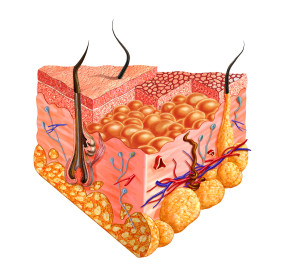 Low threshold mechanoreceptors in the skin and joints, called LTMs, include senses of pressure, vibration, temperature, itch, chemicals, and pain. Each produces distinct signals to specific regions in the cortex.
Low threshold mechanoreceptors in the skin and joints, called LTMs, include senses of pressure, vibration, temperature, itch, chemicals, and pain. Each produces distinct signals to specific regions in the cortex.
Touch is very connected to motor movement through rapid myelinated neurons that trigger reflexes. Fast fibers are necessary for discriminative function, where the signal must identify stimuli and objects and then send signals to the spinal cord for a reflex or the cortex for a thoughtful response, and then rapidly back to muscles for a behavior. An example of rapid sensation and reflex response is pulling the hand away from a hot object. The myelination in these axons produces speeds of 50 times greater than if they were not myelinated.
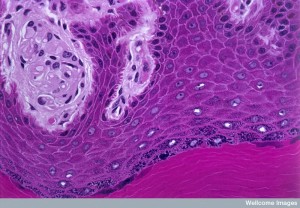 Different types of skin have dramatically different numbers of these different receptors. Two types of skin include one on the palms and the bottom of the foot and another on the “hairy skin” on much of the rest of the body, including arms, chest and back.
Different types of skin have dramatically different numbers of these different receptors. Two types of skin include one on the palms and the bottom of the foot and another on the “hairy skin” on much of the rest of the body, including arms, chest and back.
There are a great number of different fibers in the palms and fingers. These can very accurately distinguish the shapes and texture of objects, including pressure and vibration. In fact the representation in the cortex of the hand has more fibers going to the somatosensory cortex, than the entire body. (See the picture below of the homunculus representation in the sensory cortex. It shows that the hand and fingers have as large a cortical area representation as the rest of the body).
Some neurons specifically pick up moving objects; some are especially for constant pressure. There are fibers that are deeper to pick up the amount of pressure. Others pick up low frequency vibrations. These different fibers account for many different aspects of perception in touching with the hands.

A fiber that senses a small pulsed current, alerts the system. Another only triggers when multiple are triggered at the same time, providing spatial information; this helps body movement, giving information about joint movement and motor control. Also, there are high frequency and low frequency channels.
The innervation of the hand is very complex, but does not have the special fibers of social touch. In fact, although the hand is involved in social situations, the pleasure appears to be culturally learned, not innately wired.
Special Fibers in Hairy Skin
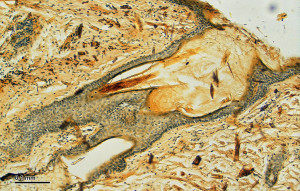 There have been far fewer studies on the hairy skin that is much of the rest of the body, and only recently have studies shown fibers that are involved uniquely in social touch in these areas. Five different fast fibers have been found in hairy skin of the forearm, but their exact functions are not yet clear. These project to the dorsal horn of the spinal cord as the first relay in the nervous system, not the somatosensory cortex. The central pathways are not known.
There have been far fewer studies on the hairy skin that is much of the rest of the body, and only recently have studies shown fibers that are involved uniquely in social touch in these areas. Five different fast fibers have been found in hairy skin of the forearm, but their exact functions are not yet clear. These project to the dorsal horn of the spinal cord as the first relay in the nervous system, not the somatosensory cortex. The central pathways are not known.
Recently, a totally different class of unmyelinated low threshold receptors was found in these regions. These fibers respond to gentle mechanical force and are called the C tactile afferents or CTs.
 Axons with little myelin or none (see post on the New Myelin Code) have been noted to be part of the circuits for internal states such as feelings, rather than sensations. These same fibers control the unconscious function of our internal organs that are also highly connected to feelings (see post on Feelings in the Brain). These fibers are very slow compared with sensory neurons (10 to 40 times as slow). In previous posts unmyelinated fibers were noted to have very unique qualities; they have been shown to have communication with local immune cells by newly discovered secretions along the axon to the local region; this local communication between immune cells and the unmyelinated axon work together against inflammation and fighting microbes.
Axons with little myelin or none (see post on the New Myelin Code) have been noted to be part of the circuits for internal states such as feelings, rather than sensations. These same fibers control the unconscious function of our internal organs that are also highly connected to feelings (see post on Feelings in the Brain). These fibers are very slow compared with sensory neurons (10 to 40 times as slow). In previous posts unmyelinated fibers were noted to have very unique qualities; they have been shown to have communication with local immune cells by newly discovered secretions along the axon to the local region; this local communication between immune cells and the unmyelinated axon work together against inflammation and fighting microbes.
 The newly discovered CT fibers have unusual properties of both. They have low threshold, but are unmyelinated like the emotion cicuits. CT fibers were first discovered years before as having unusual low spikes along the neuron, but it was not clear what they responded to or where they went in the brain. These CT unmyelinated fibers respond to gentle stroking and are found along the arms and legs.
The newly discovered CT fibers have unusual properties of both. They have low threshold, but are unmyelinated like the emotion cicuits. CT fibers were first discovered years before as having unusual low spikes along the neuron, but it was not clear what they responded to or where they went in the brain. These CT unmyelinated fibers respond to gentle stroking and are found along the arms and legs.
CT fiber circuits are very complex with a great amount of branching in the boundary of the dermis and epidermis. They are not on the palms of the hands or fingers. They respond to very low pressure and respond with very high frequency to gentle stroking of a soft brush. This high frequency is unusual and is more often seen in the fast fibers of sensation. It is not clear how they are related to the ordinary discrimination of objects. They fall in the middle of the characteristics of other better-known fibers.
Special Fibers for Gentle Touch
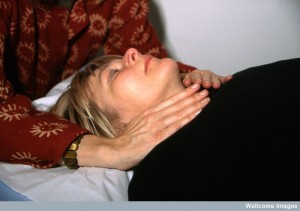 What is very interesting is that there is great variation in the effects of these fibers, which implies that there are many different types that are just not yet understood. Motions that are part of massage, that is, low force stroking movements, stimulate these CT nerves very strongly. Too many repeats cause a decrease in the signal in some fibers, but not others. As mentioned above, it is extremely difficult to follow a very thin fiber that elaborately branches and travels to many parts of the brain. CTs don’t respond to irritants like severe heating, but do respond to very mild cooling. The combination of mild touch and mild cooling is a strong signal.
What is very interesting is that there is great variation in the effects of these fibers, which implies that there are many different types that are just not yet understood. Motions that are part of massage, that is, low force stroking movements, stimulate these CT nerves very strongly. Too many repeats cause a decrease in the signal in some fibers, but not others. As mentioned above, it is extremely difficult to follow a very thin fiber that elaborately branches and travels to many parts of the brain. CTs don’t respond to irritants like severe heating, but do respond to very mild cooling. The combination of mild touch and mild cooling is a strong signal.
Studies show that their optimal firing correlates with subjective pleasurable feelings. The opposite occurs in the faster myelinated fibers, which respond best to pain and irritants.
Another unique characteristic of CTs is that they fire best with neutral temperature and slow movement of touch. The faster fibers get stronger with speed of touch. They exist either in the dermis by themselves or surrounding hairs in the epidermis. Recently, at least three subtypes have been identified.
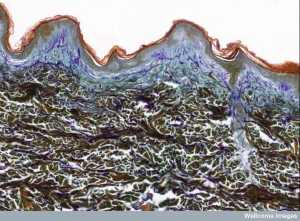 It is very difficult in research to stimulate these very small fibers without also stimulating the faster discriminatory type. But, studies have been possible with patients who have neuropathy, which damages the faster fibers, as well as joint and muscle fibers. In these patients brushing results occurred in the CTs and not the palms.
It is very difficult in research to stimulate these very small fibers without also stimulating the faster discriminatory type. But, studies have been possible with patients who have neuropathy, which damages the faster fibers, as well as joint and muscle fibers. In these patients brushing results occurred in the CTs and not the palms.
The results of stimulation show that subjective awareness of these fibers is vague, and quite variable in different people and different situations. It is hard for people to describe the sensation of brushing. The same stimulation was subjectively experienced as different on different occasions and between different people. However, it is not described as pain, tickle, or itch; it is pleasant, either slightly or moderately.
Spinal Relay of Social Touch
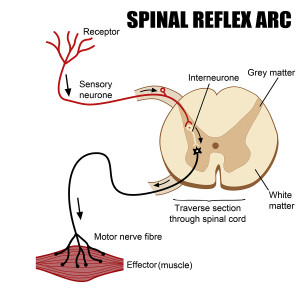 The soft touch sends signals to a particular level of the spinal dorsal horn. The dorsal horn is a well-known ganglion in the spinal cord that consist of neurons that relay fibers to the brain involving pain and discriminatory touch.
The soft touch sends signals to a particular level of the spinal dorsal horn. The dorsal horn is a well-known ganglion in the spinal cord that consist of neurons that relay fibers to the brain involving pain and discriminatory touch.
The CT fibers of social touch uniquely go to the inner lamina 2 of the dorsal horn, and then connect vertically with lamina 1 where the pain fibers go. From lamina 1, they go to the spino-parabrachial neurons. One set of neurons specifically sends pain signals—“negative experience”—in this tract. But the other sends the “positive affect” type. Another type of relay in lamina 5 is only for the touch that is used for discrimination of objects. The CT fibers travel near the pain fibers.
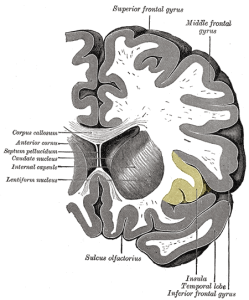 Studies have traced the positive social effect fibers to the thalamus nuclei and then to the insula cortex, well known for emotion. When surgical procedures to stop intractable pain, also, cut these fibers, they eliminate the positive pleasurable sensations. This research identifies a specific tract from the spine to the thalamus, then to the insula from pleasurable stroking. Also, the classical areas of the cortex that deal with somatosensory signals (S1 and S2) are also involved with the posterior insula. But, the S1 and S2 region’s effects on CTs is to inhibit them, showing that it is not part of ordinary touch sensation.
Studies have traced the positive social effect fibers to the thalamus nuclei and then to the insula cortex, well known for emotion. When surgical procedures to stop intractable pain, also, cut these fibers, they eliminate the positive pleasurable sensations. This research identifies a specific tract from the spine to the thalamus, then to the insula from pleasurable stroking. Also, the classical areas of the cortex that deal with somatosensory signals (S1 and S2) are also involved with the posterior insula. But, the S1 and S2 region’s effects on CTs is to inhibit them, showing that it is not part of ordinary touch sensation.
The insula was discussed in great detail in two posts on emotion, feelings and body maps in the brain. It is the gateway to the higher centers of emotion in the frontal lobe. In fact, the CT fibers go from the insula to the medial prefrontal cortex and cingulate, centers of emotional decision-making. While some palm fibers are pleasurable, they do not go to the insula. The pleasure from the palm fibers appears to be a culturally learned phenomenon.
Further research implies that the pleasurable CT tract to the limbic system is not learned but innate. The palm type of stimulation that can be pleasurable is actually a mild form of pain and is a learned pleasure. The CT pleasurable sensation is not learned but is an innate tract for social experience.
Social Touch
 Evolutionary theory assumes that pleasurable feelings, reward and punishment are related to survival issues. Pain has clear survival utility and is connected to rapid responses.
Evolutionary theory assumes that pleasurable feelings, reward and punishment are related to survival issues. Pain has clear survival utility and is connected to rapid responses.
There are two levels of response in touch. The first touch demonstrates an object to be attended to.
The second touch signal—the CT—is triggered only by a specific type of stimulus that triggers an emotional response. It is a pleasant skin-to-skin touch that promotes social behavior. It is becoming clear that whole regions of the brain are related to social behavior and related rewards. When given a placebo with the expectation of increased pleasure, the CT fibers have a much greater effect in the insula. When the expectation is for decreased pain, then there is less effect in the insula and more effect on pain centers.
Other studies have shown that the pathways of pleasurable touch are connected with the sense of body ownership (see post on body maps). The lamina II consists, mostly, of interneurons that travel with the pain fibers. It is possible that pleasure fibers also play a role in the complex pain circuits, such as hypersensitivity.
Social Brain
 Most social brain research is based on visual and auditory regions. Touch is, also, very significant in social interactions such as hand shaking, caressing , hand holding, dancing and hugging. In politics, there is no better social connection than a handshake. Hand shaking is greatly emphasized by another hand’s gentle or firm touch on the arm or shoulders, which would include these strong emotional signals. A hug is an even stronger emphasis. In fact, physical touch involves more emotion than speech and strongly demonstrates attention.
Most social brain research is based on visual and auditory regions. Touch is, also, very significant in social interactions such as hand shaking, caressing , hand holding, dancing and hugging. In politics, there is no better social connection than a handshake. Hand shaking is greatly emphasized by another hand’s gentle or firm touch on the arm or shoulders, which would include these strong emotional signals. A hug is an even stronger emphasis. In fact, physical touch involves more emotion than speech and strongly demonstrates attention.
If patients are touched by nurses before surgery, they have less stress. Gentle touch can lower blood pressure and decrease pain. Gentle touch is a critical part of the development of children including increased learning. Grooming behavior in primates is critical for social cohesion.
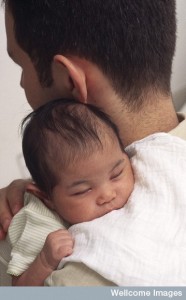 In attachment theory, children seek physical contact with the caregiver. This contact is the signal to children that they are safe and loved. Nurturing and social interactions depend upon positive social touch. This is a biologically necessary factor not just a culturally acceptable one.
In attachment theory, children seek physical contact with the caregiver. This contact is the signal to children that they are safe and loved. Nurturing and social interactions depend upon positive social touch. This is a biologically necessary factor not just a culturally acceptable one.
Many hormones and neurotransmitters—opiods, oxytocin, dopamine and serotonin—modulate social touch in the brain, as well as other aspects of social interaction.
Natural opiates are involved in social bonding. Grooming creates social bonds in primates, including humans and stimulates the natural opiates—the endorphins. This effect is less when given morphine and increased with opiate antagonists. The larger the group, the more grooming occurs to keep the group cohesive. Social touch activates  the brains’ opiod regions as seen by PET scan. During social touch situations, there is higher opiate binding in the striatum and cingulate (reward circuits.) Also, μ-opiod receptors are involved in natural reward and pleasure and, also, infant bonding and attachment.
the brains’ opiod regions as seen by PET scan. During social touch situations, there is higher opiate binding in the striatum and cingulate (reward circuits.) Also, μ-opiod receptors are involved in natural reward and pleasure and, also, infant bonding and attachment.
Oxytocin from the posterior pituitary is involved in social interactions. With touch and oxytocin, reactions both negative and positive, are heightened. Oxytocin does not have a direct effect on the touch experience, but is very connected to serotonin effects. Serotonin is known to be involved in attachment, social bonding and perceptions.
Animals that lick and groom have less stress through an effect of serotonin. Social isolation causes an overall decrease in serotonin. The drug MDMA, considered a drug that stimulates social interaction, increases serotonin and the social effects of touch.
Interestingly, just watching people touch affects the insula as well as the somatosensory cortex. Therefore, those that are part of a grooming or touching group benefit by observation.
Social Touch in the Fetus and Childhood
 In the infant, the sense of touch is highly developed compared with other systems. In fact, many aspects of the social brain are present at birth, with the CT skin fibers activated by the amniotic fluid, stimulating social centers such as the hypothalamus and the insula. Touch is the first sense in utero, as it is, also, the first sense in evolution.
In the infant, the sense of touch is highly developed compared with other systems. In fact, many aspects of the social brain are present at birth, with the CT skin fibers activated by the amniotic fluid, stimulating social centers such as the hypothalamus and the insula. Touch is the first sense in utero, as it is, also, the first sense in evolution.
The sense of one’s body and skin helps create a sense of self as opposed to “other.” This sense of self is highly related to the CT touch fibers.
Harlow found that infant monkeys preferred a soft doll rather than a hard doll with food. It has been found that licking and grooming of rodent infants permanently decreases stress and aggressive behavior. These behaviors reset the neuropeptide oxytocin and vasopressin for life.
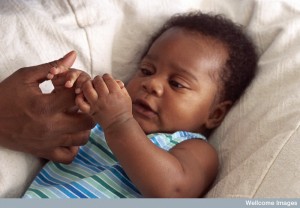 In humans, the quality of mother child touch is very biologically significant and uniquely benefits the infant. It is the CT soft touch fibers that stimulate smiling in the baby. This effect in humans decreases cortisol reactions and increases the number of hippocampus cells with increased learning. Spitz found that infants without parents in facilities that were clean, well fed and warm, but had no touch, died more frequently. When mother and child did not touch immediately after birth, there were negative mother child interactions a year later.
In humans, the quality of mother child touch is very biologically significant and uniquely benefits the infant. It is the CT soft touch fibers that stimulate smiling in the baby. This effect in humans decreases cortisol reactions and increases the number of hippocampus cells with increased learning. Spitz found that infants without parents in facilities that were clean, well fed and warm, but had no touch, died more frequently. When mother and child did not touch immediately after birth, there were negative mother child interactions a year later.
Social Touch Brain Pathways
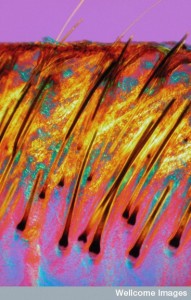 As science is able to discover the anatomy and function of smaller and smaller nerve fibers throughout the body, spinal cord and brain, totally new types of fibers are being uncovered. It has been clear that touch is uniquely important for all types of social interactions, and critical for bonding in families, personal healing, and the cohesion of society at large.
As science is able to discover the anatomy and function of smaller and smaller nerve fibers throughout the body, spinal cord and brain, totally new types of fibers are being uncovered. It has been clear that touch is uniquely important for all types of social interactions, and critical for bonding in families, personal healing, and the cohesion of society at large.
The new CT fibers that have been discovered are helping to explain the unique effects of gentle, soothing, healing touch. These fibers are highly branched and travel through the spinal cord to the insula and then to the cortex and the limbic system—the basic brain centers of emotion. They are uniquely responsible for pleasurable social touch. The CT touch circuit is highly connected with a wide range of neurotransmitters and hormones that are critical to emotions and social interaction. While many have thought that vision, hearing and smell are the most important senses of the social brain, in fact, touch has uniquely important social effects. The distinctive properties of the CT fibers may help explain this extremely important form of social communication.